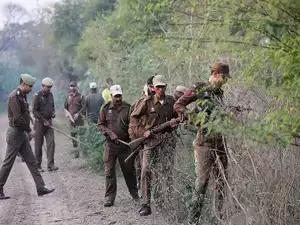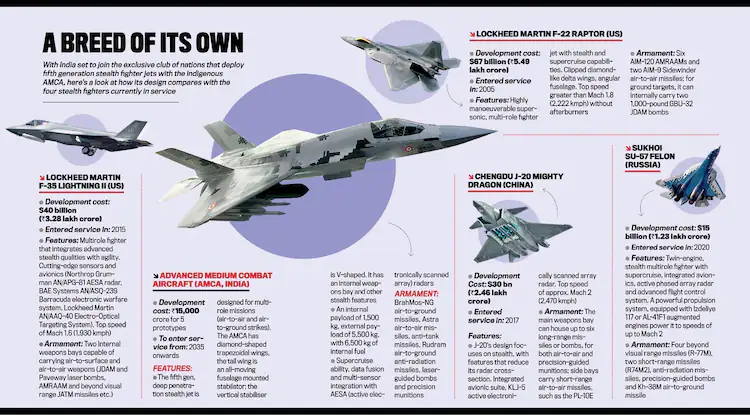The Cabinet Committee on Security has flagged off the prototype development and testing stage of India’s indigenous fifth-generation stealth fighter jet, the Advanced Medium Combat Aircraft (AMCA). Slated to be in production from 2035, it would make the IAF battle-ready for the future
With air power being regarded as the sword arm of offensive operations, as well as crucial in defense, in all modern military doctrines, developing more sophisticated fighter jets has been a continuing objective for top military powers. The term ‘fifth generation fighter aircraft’ (FGFA) is currently used to denote the few most technologically advanced fighter jets—a super elite category—that have been developed over the past 30 years. Such machines have multirole capability, advanced avionics, and networked data fusion (enabling greater situation awareness on the battlefield). But the one quality that sets a fifth generation jet apart from other modern fighters is its ‘stealth’ capability—the quality of being unseen and undetected by enemy’s ground defense radars and aircraft.
Bangladesh vs Zimbabwe Live Score, Streaming Details: When And Where To Watch…
As can be imagined, making a FGFA is a complex task, and only a few
Fighters inhabit that class—the Lockheed Martin F-35 Lightning II and F22 Raptor (US), the Chengdu J-20 Mighty Dragon (China), and the Sukhoi Su-57 Felon (Russia). On February 21, Turkey conducted the maiden test flight of its indigenously developed fifth-generation stealth fighter jet, Kaan. It is developed by Turkish Aerospace Industries and BAE Systems of the UK.

Here in India, aerospace engineers at the Aeronautical Development Agency (ADA) complex in Vimanpura, an aeronautical hub in Bengaluru, have been quietly working on designing India’s own fifth-generation stealth jet—the Advanced Medium Combat Aircraft (AMCA)—since 2009. Now, in a push that could propel India into the exclusive club of nations that operate FGFAs, the Cabinet Committee on Security (CCS), the country’s highest body on security matters, gave its nod to the next stage of the AMCA project on March 7 by sanctioning Rs 15,000 crore for its prototype development. The five twin-engine prototypes would be made by the ADA—which functions under the Defence Research and Development Organisation (DRDO) of the Ministry of Defence (MoD)—and Hindustan Aeronautics Limited (HAL), with support from Indian private firms. The ADA has a 10-year roadmap for making the five prototypes and flight testing thereafter. The prototype itself would take four years to manufacture. If all goes according to plan, the AMCA will start being manufactured from 2035 onwards.
The AMCA is the most significant military project cleared by the Narendra Modi government before the Lok Sabha election. However, it is learnt that there was opposition, including from a section in the armed forces, against the AMCA on account of its high cost. But its developers told the PMO that the project risked losing its relevance if it did not receive the go-ahead now, and that other countries, just like Turkey has, would steal a march on India in developing a stealth jet.
Military aviation experts claim that Turkey started working on its stealth jet in 2010, a year after India announced its own FGFA programme. In 2015, Turkey announced that it would partner with BAE Systems to design the fighter. In contrast, India and Russia (HAL and Russia’s Rosoboronexport and Sukhoi) entered into an agreement to jointly develop a fifth generation jet in 2010, but New Delhi pulled out of it in 2018, after it was felt that the Russians were not willing to share much in terms of technology. The decision to go it alone led to a delay in India’s stealth development.
The Indian Air Force (IAF) plans to deploy around 120 AMCA stealth fighters (six squadrons) starting from 2035. The first two AMCA squadrons will consist of the Mark I version, and will be powered by the American GE Aerospace’s F-414 engines; the remaining four squadrons will have the more advanced Mark II version, with a more powerful, indigenous engine to be developed jointly with foreign collaboration.
State-of-the-art technology
To be capable of avoiding enemy radars and air defence mechanism, a stealth fighter uses specialised paint coating and radar-absorbing material to reduce radar bounce-off, exhaust nozzles that reduce infrared radiation emitted by the engine, exhaust plume and fuselage, technology that reduces the heat signature of the engine and special radars to minimise emissions that enemy radars can pick up. Tied to stealth capability is the internal storage of smart weapons and the ability to supercruise—the sustained supersonic flight of a jet without using afterburners, the component in jet engines used to increase thrust during take-off and supersonic flight—thus making it truly trail-less. The ADA claims to have developed similar technology indigenously. The AMCA will be based on the concept of ‘first look, first kill’ where an AMCA pilot would see an enemy plane first, fire a missile and destroy it before the latter can react. Typical qualities of a fifth gen fighter like low observability and ‘first look, first kill’ capabilities are unavailable in most front-rank fighter jets. In the IAF inventory, not even the Rafales have them. The AMCA will be designed to perform a variety of missions, including air supremacy, ground strike missions, suppression of enemy air defenses (SEAD) and electronic warfare.
AMCA designers say that the jet will have a top speed of nearly 2,600 kilometres per hour (Mach 2.15), as well as a combat range of 1,620 km. The fighter will be equipped with a 23 mm cannon and 14 hard points to carry weaponry weighing 6,500 kg. The design is intended for multi-role missions, and to tackle both air-to-air and air-to-ground operations with equal lethality. It also features serpentine air intakes, extensive use of radar-dampening materials, a conformal antenna (embedded in the fuselage, rather than sticking out from it, as in non-stealth jets), and an internal weapons bay—all essential to provide a very low radar signature.
A defence source says that the AMCA will carry BrahMos-NG (next generation) air-to-ground missiles, Astra air-to-air missiles, anti-tank missiles, Rudram air-to-ground anti-radiation missiles, laser-guided bombs and precision munitions.
Dr Ashish Kumar Ghosh, known as the ‘AMCA man’ since he was its project director since inception, tells india today that designers at the ADA have been waiting for the government’s nod for years. Underlining the project’s importance for national security, he says that after years of hard work, India finally has developed its own stealth technology. Now retired, Ghosh also points out that not all fifth generation jets have every ‘stealth’ feature. “But India’s AMCA is going to be a real stealth jet,” he says. The AMCA, emphasises Ghosh, is not a copy of any existing platform. It also must be mentioned that the AMCA’s design and the development of its various technologies happened in tandem.
Dr Girish Deodhare, former head of the ADA, says he is delighted with the government’s go-ahead. “We have been working on the AMCA for over a decade. Government sanction came at the right time, as most of the technologies are matured.”
Another senior scientist involved in the project points to the all-round effort taken to develop the cutting-edge stealth technologies. “For LCA (Light Combat Aircraft) Tejas, we had some consultancies. But when fifth gen technologies came up, these consultants would clam up. So, all the technologies have been developed indigenously, with many trials and errors. It has been a truly national effort,” he says. Agencies involved included DRDO labs, academic institutions, CSIR (the Council for Scientific and Industrial Research) labs, PSUs and private agencies.

The long struggle
In 2005, after the US launched the F22 Raptor, India formed a study group to consider 5th Gen Fighter jet capabilities. Subsequently, in 2009, a budget of Rs 90 crore was given to the ADA to carry out a feasibility study for a stealth fighter jet. Four years later in 2013, AMCA developers worked out the first feasible configuration, which was accepted by the IAF.
But, in between in 2010, enthused with the success of the India-Russia BrahMos cruise missile project, both nations agreed to develop an FGFA in a joint venture. A preliminary design contract was inked, with the agreement that Russia would procure 250 and India 144 aircraft at a cost of around $30 billion (Rs 2.46 lakh crore) by 2022. After working jointly for years, India pulled out of the project in 2018 over differences with Russia on issues like the transfer of technology and design specifications of the aircraft. That same year, the government approved an additional Rs 447 crore for completion of the design and development of stealth technologies for India’s future 5th Gen Fighter.
Over the past decade, the absence of a roadmap for jet engines slowed down India’s fighter jet programme, including the AMCA project, as New Delhi negotiated with Washington for the joint production of GE 414 engines in India. With the US agreeing to share jet engine technology with India in 2023, the first 40 AMCAs are expected to fly on these GE engines. The advanced AMCA Mark II version will need a more powerful 110kN high-thrust engine for better supercruise abilities, which will be co-developed in India.
Since a 5th Gen Fighter stealth fighter is an extremely high-cost platform, no country with the capability has it in large numbers. Likewise, the IAF has expressed a need for six squadrons of the AMCA (including four of the Mk-II version). The first five prototype jets will cost nearly Rs 900 crore each, but the cost will reduce at the production stage.
All sensors, avionics and flight control systems of the AMCA are to be indigenous—over 70 per cent of the aircraft—except for the GE-414 engine and the ejection seat. “Since AMCA is an indigenous 5th Gen Fighter aircraft, it is less costly than similar aircraft available outside,” Ajay Bhatt, the minister of state for defence, stated in Parliament in 2022.
By the IAF’s reckoning, the 5th Gen Fighter would form an important element of future air combat. Air Marshal S.B.S. Sinha (retd), former deputy chief of the IAF, points out that centres of gravity (points of strength of a military) of every country are heavily defended by a mix of long-range sophisticated missile systems. “Therefore, you require stealth aircraft to beat enemy’s AD (air defence) sensors to neutralise high-value targets, while other fighters continue routine missions. Stealth aircraft can also be used in non-stealth roles, wherein it can carry heavy underwing and underbelly weapons like normal fighters,” he adds.
Ghosh says that now that the government has allocated the budget, the prototypes must be made at the earliest. He stresses that the capability of manufacturing the AMCA also needs to be developed speedily once a final version has been certified. “Only then can we get the best of its 5th Gen Fighter next generation features,” he says.










